Go To Trains 2 Go To Trains 3A
Go To Trolleys Part 1
Unless otherwise stated in this post, click on an image for a larger view. Click a major heading, e.g., "INTRODUCTION," to move to the next section.
INTRODUCTION. A funny thing happened as I was passing through my whistle stop at Trains 2 and getting ready to be on my way to the next and then last scheduled stop in this series, Okc Trolleys & Interurbans. I'd pretty well done my research for that article and had gobs of pictures that I couldn't wait to post ... but, as it developed, my "train" got switched onto a different than intended track and made an unscheduled stop in the office of Mr. Dean Schirf.
It began on August 27 last when I received a kindly and flattering e-mail from Mr. Schirf which wondered if I might like to drop by his office to take a look at some of the pictures and articles that were in the archives of the organization he represents. "Sure," I said, "What about tomorrow sometime?" He replied to the effect, "9 a.m. tomorrow is good for me," and so, at 9 a.m. on August 28 I presented myself to the receptionist at the Greater Oklahoma City Chamber of Commerce at 123 Park Avenue, signed in, and was then greeted by someone whose name I'd never known until the day before which, if you don't already know you will shortly see, was uncommonly dumb of Doug Dawg not to know.
But, I'm getting ahead of myself.
 On entering Mr. Schirf's office, I was taken by the railroad pictures and other Oklahoma City memorabilia which adorned his office. He seated me at a round table and proceeded to show me several folders of pictures which he'd pulled together for our meeting and which had remained in the Chamber's collection after an earlier donation of many, many more such items to the Oklahoma Historical Society. He wondered if I would like to look at and use some of them, crediting the Chamber, and I eagerly said, "YES!" and "YES!" (The Chamber's portal page is http://www.okcchamber.com/, by the way.)
On entering Mr. Schirf's office, I was taken by the railroad pictures and other Oklahoma City memorabilia which adorned his office. He seated me at a round table and proceeded to show me several folders of pictures which he'd pulled together for our meeting and which had remained in the Chamber's collection after an earlier donation of many, many more such items to the Oklahoma Historical Society. He wondered if I would like to look at and use some of them, crediting the Chamber, and I eagerly said, "YES!" and "YES!" (The Chamber's portal page is http://www.okcchamber.com/, by the way.)I (only coincidentally) just happened to have my camera with me and he allowed me to take several pictures during the visit and he gave me copies of three published articles he'd written. We talked about the Chamber's long-standing history vis a vis trains in Oklahoma City. We talked about his personal long-standing interest in trains beginning with his childhood days in El Reno and then Chickasha.
This guy was/is clearly a "train afficionado" and I think that he'd thought I might be one, too, given the post I'd made in Trains 1 ... hopefully it wasn't too much of a disappointment when I confessed that I was "new" to trains and was just learning ... but that didn't dampen his enthusiasm for what he had to say and show.
 Time quickly flew by. Before leaving his office, he gave me his business card. He'd earlier told me that he was the Corporate Secretary for the organization but the significance of that title didn't then register in Dumb Doug Dawgz handsome but internally fuzzy head. The next day, I read the three articles he'd given to me. The first is an article called, "The Rock Island Railroad and My Friend Red," previously published in the Chickasha Daily Express and the Rock Island Digest and presently submitted for publication in the quarterly Remember the Rock, a journal-type magazine by Andover Junction Publications. After I quit bawling from that read, I read the other two articles, one called, "Railroads Play Major Part in Settlement of State, Country," published in and which you can read on-line at The Journal Record's website but only if you are subscriber to that website, or duplicated here below, and another, "Chickasha and the Rock Island Railroad," in The Rock Island Digest, a publication of the Rock Island Technical Society (RITS). The Digest is not available on-line but this link and scroll down to Vol 12, 1995, and you'll notice the word, "Chickasha," and that's the issue.
Time quickly flew by. Before leaving his office, he gave me his business card. He'd earlier told me that he was the Corporate Secretary for the organization but the significance of that title didn't then register in Dumb Doug Dawgz handsome but internally fuzzy head. The next day, I read the three articles he'd given to me. The first is an article called, "The Rock Island Railroad and My Friend Red," previously published in the Chickasha Daily Express and the Rock Island Digest and presently submitted for publication in the quarterly Remember the Rock, a journal-type magazine by Andover Junction Publications. After I quit bawling from that read, I read the other two articles, one called, "Railroads Play Major Part in Settlement of State, Country," published in and which you can read on-line at The Journal Record's website but only if you are subscriber to that website, or duplicated here below, and another, "Chickasha and the Rock Island Railroad," in The Rock Island Digest, a publication of the Rock Island Technical Society (RITS). The Digest is not available on-line but this link and scroll down to Vol 12, 1995, and you'll notice the word, "Chickasha," and that's the issue.Hmmm ... I thought to myself, "I want to know more about Dean Schirf." I'd already learned of his kindly and unassuming temperament when we met on August 28, and of his generosity, too, and, by the time I finished reading his articles, I knew a little about his scholarship and his excellent way with words. I decided to Google his name ... and I found plenty! For example, a January 30, 2003, Journal Record article says this:
Dean Schirf has been honored by the Greater Oklahoma City Chamber of Commerce for 25 years of service.I Googled his name some more using the word "Amtrak" as a qualifier and quickly discovered that Dean is and was in the forefront of getting, keeping, and expanding, Amtrak service here. As far as him being quoted is concerned, it happens a lot!
Schirf, corporate secretary and vice president of government relations, community improvement and education, was initially hired to serve as the assistant director of economic development but was soon made director of government relations. He has also served as corporate secretary since 1982.
“He is the best government relations director the chamber has ever had,” Paul Strasbaugh, general manager of the Oklahoma Industries Authority and former president of the chamber, said at the ceremony recognizing Schirf for his 25 years of service.
He led chamber efforts on a wide variety of legislative and government relations initiatives. He has participated in the creation of economic development incentives such as the Quality Jobs Act and workers compensation reform, and tax reform.
Among the highlights of Dean’s career was the passage of a right-to-work law. For more than 20 years Dean worked to make sure the issue was regularly considered by the Legislature.
And, so, there you are .... Doug Dawgz ignorance was (again) exposed! One might think that I'd then be too embarrassed to ask ... but, Doug Dawg knows no shame ... so I asked him if he would consider allowing me to do an article (who knows ... it may be several before it's done) called, The Dean Schirf Collection and, after talking it over with his family, he agreed! Hooahh! This is the first of hopefully many installments.
Dean Schirf will NOT like this introduction. As he told me and as I observed, he is not one to draw attention to himself. I replied to his concern thusly:
As far as the possible post being in the nature of attracting attention to yourself, though, that would not be the case. In the first place, I asked you ... you didn't ask me! While I'd want to call the post, "The Dean Schirf Collection," or something similar, it would be the substantive content which would receive the focus, just like it was with what I did with Norman Thompson's generous contributions which, I thought, gave the community (and others interested – interestingly, the Springlake post has had frequent hits from all around the country [and judging by that is one of the most popular posts so far in Doug Dawgz Blog]) a few pictorial glimpses into Okc history which had been rarely seen at least in a "present" way. That's what it's all about! * * * Every now and again it's people like Norman (and you) who are in a unique position to make such a contribution.So, when I got the "I'm all aboard" reply from him yesterday, Doug Dawgz tail wagged furiously!
This article begins a magnificent series not only by one who tells and writes about history but by and about one who also makes it! It doesn't get any better than that! So, even though he is not drawn to giving himself attention, Doug Dawg feels no such restraint! And, I think that his family will be happy that I wrote this intro, instead of me asking Dean to do it!
End of Introduction. Over the next days, weeks, and months, this post will be edited from time to time to add lots of stuff that fits the definition of The Dean Schirf Collection. I'm expecting it to include, but not be limited to, Oklahoma City, since Dean's environs extend beyond our metro. Enjoy!
THE FIRST STORY. Rather than starting with the many pictures which will hopefully come to adorn this article, I'd rather start with a story ... a poignant account told by Dean about "His Good Friend, Red" because it gives you a glimpse into the history that will be told here and the character of the man who will be telling it. As noted above, this article has been published in The Chickasha Daily Express and The Rock Island Digest. When it becomes available to me, I'll add a picture of Dean and Red which was taken when they met again later in life, described below.
FIRST VISUAL IMPRESSIONS ON DEAN'S WALLS. On my first visit, I took a few pics that were on the walls in Dean's office. They make a good imagery start since they involve both the old and the new.
ROCK ISLAND TRACKS IN BRICKTOWN. Adorning one wall in Dean's office is a magnificent photograph given to him by the Oklahoma Department of Transportation, taken from the top of the First National Bank looking east. It's quite large (I didn't measure, but it's big) and it shows the Rock Island tracks in the north Bricktown area. The image is not dated but I'm guessing that it was taken around 1930-1933 because (1) the "new" viaduct did not open with its new center section until April 1938 even though reconstructed approaches were started in 1934, and (2) the Stiles grade crossing was done in 1934 and it does not appear in this photograph. By the way, in case you're wondering, an on-line dictionary defines a "viaduct" (apparently a preferred word in days gone by) as a "bridge composed of several small spans. The term viaduct is derived from the latin via for road and ductus to conduct something." OK, OK, I'll just call it a "bridge." The picture below shows the original bridge which was constructed during 1904-1905.
For a high resolution image, click here.
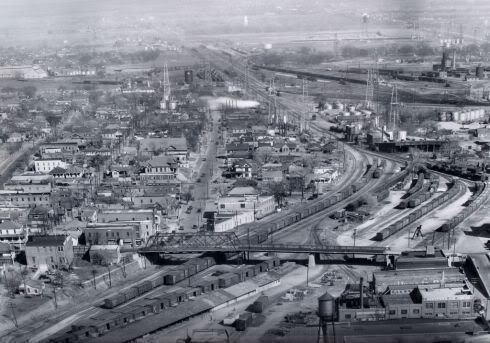
If you're as confused as I was when I first tried to figure out this unfamiliar picture, the following images will help to give orientation and perspective.
This "doctored up" 1922 Sanborn Map shows the streets and locations of the two identified-by-name buildings and the Rock Island Roundouse in the picture (for "undoctored" and larger images of this map, click here):
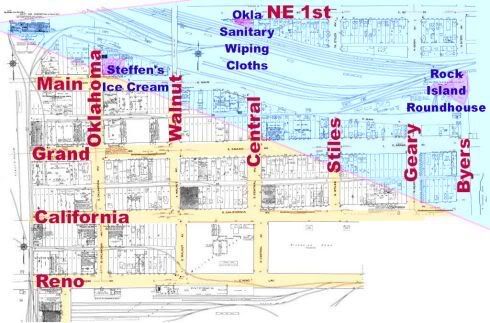
Here's a more contemporary view (larger image not available).
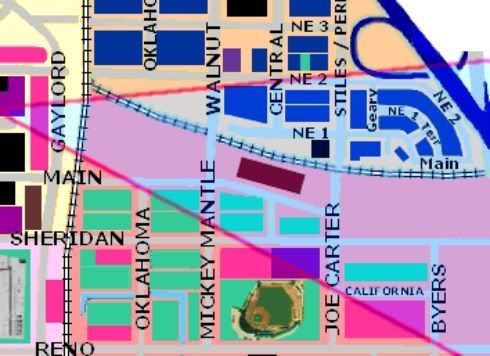
The "pieces" of this picture deserve a closer look. Cropped areas are shown below.

The Rock Island Roundhouse
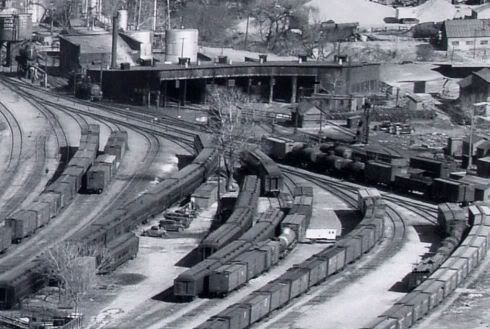
1922 Sanborn Map Showing the Roundhouse
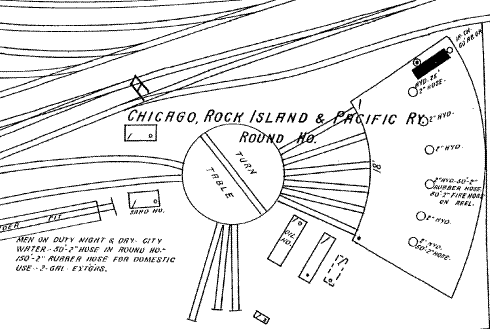
The Southern Side of Deep Deuce
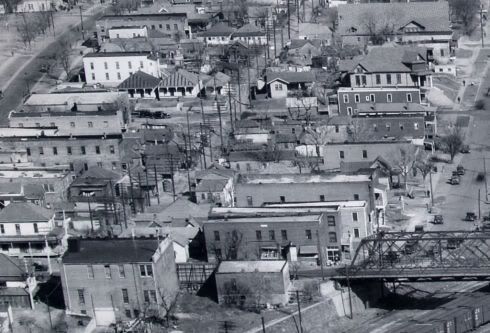
It's too bad that the photographer didn't capture more of Deep Deuce, but you can fairly well see the buildings and perhaps you can even identify a few. NE 2nd Street is at the left and NE 1st is at the right. The Avery AME Church at 429 E. 1st (NW Corner of 1st & Geary), shown in Deep Deuce History, is observable at the top right corner of the above picture and is shown below.
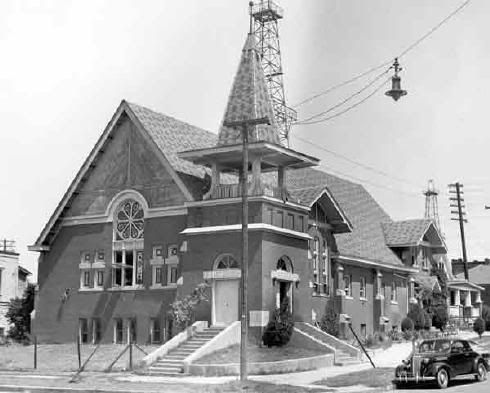
AMTRAK. On another of his office walls, Dean has these two pictures that he took on May 5, 2001, and which were included in his September 16, 2002, Journal Record article which follows the pics, below. You'll see more Amtrak pics in Trains Part 3A. The Heartland Flyer's very nice website is www.heartlandflyer.com -- click the previous link or the image below to check it out.
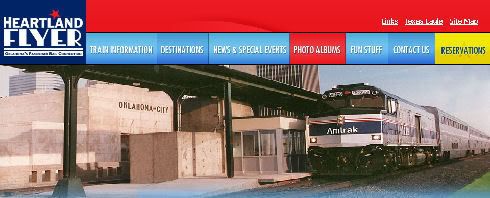
Dean's Pics
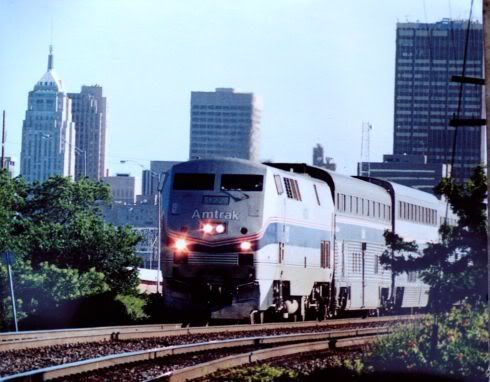
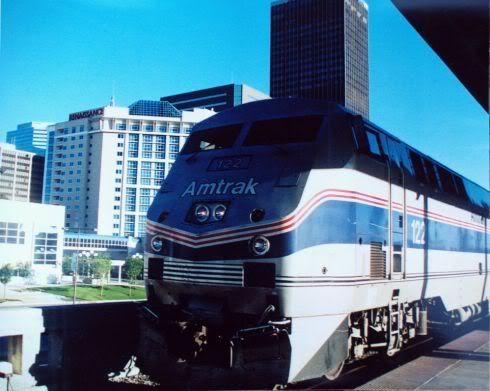
The article is available on-line at the Journal Record but only if you are a subscriber to that website. So, here it is, just in case, including some if not all of the images present in the on-line version (and in much better quality):
Guest Column by Dean Schirf September 16, 2002 For as long as I can remember, railroads have always been an attraction, dating back to when my father would take me with him to the Rock Island roundhouse in El Reno where he worked in the late 1940s. Steam engines were still very much a part of railroading and seeing those great iron horses corralled side by side under a single roof, was a sight to behold. In just a few short years the steam engine would be no more, as railroad after railroad dropped them for their rosters, replacing them with the more efficient and modern diesel/electric locomotive. In the case of the Rock Island, the last steam engine rode off into history in December, 1952. By 1960 it was hard to find a revenue running steam engine operating on a class-one railroad anywhere in the country. The history of railroading in America is really a history describing in detail the settlement of this great country. Railroads, more than any other form of land transportation, were directly responsible for where towns would be located, how markets would be established and how the free flow of goods, services and our early settlers and the traveling public got from point A to point B. Nowhere was this more evident than in the settlement of our own city. Before there was an Oklahoma City, there was the railroad. The Santa Fe Railroad was Oklahoma City's first railroad when it built its Chicago-Texas main line through Indian Territory in 1887. Almost two years prior to the April 22, 1889, land run, the Santa Fe had a small station, water tank and along with a few scattered frame structures, made up what was called Oklahoma Station. One writer at the time stated, "the whole layout wasn't worth $10,000." Of course that all changed when the unassigned lands were opened up for settlement. On the evening of April 22, 1889, Oklahoma Station had 10,000 people. Most likely the fastest-growing city in the history of the United States for a single day. Many of our city's first settlers boarded Santa Fe passenger trains in making the land run. Santa Fe ran trains all day from Purcell and from Arkansas City on the north carrying people into Guthrie and Oklahoma City. The second railroad to serve Oklahoma City was the Choctaw, Oklahoma and Gulf east/west line built in 1891 that ran from Memphis to Amarillo. This line was purchased by the Rock Island in 1902. The Frisco built into Oklahoma City in 1897 followed by the Katy in 1902. These four railroads played a most significant role in the location, growth and early development of Oklahoma City. I have often wondered where Oklahoma City would be today had not the Santa Fe located a small outpost of a depot and a water tank in 1887 and called it Oklahoma Station. The present Sante Fe station at 100 E.K. Gaylord Blvd. was its third station constructed in 1930, and is located very near the site of the original one. This spot can be pointed to as the actual birthplace of Oklahoma City. Keep in mind that the announcement of a railroad building its tracks into Oklahoma City in the late 1800s and early 1900s, could be easily compared to our city having a major airline announcement today and that we have been selected as a major hub, offering nonstop air service to all the major cities on the East and West coasts. Folks actually lost their fortunes and had their lives threatened in the determination of where railroads were going to be built and what town sites would or would not receive rail service. Early day railroads in Oklahoma City enjoyed robust business due to the city being one of the fastest-growing cities in the Southwest, and at times one of the fastest growing in the country. Its citizens primarily depended on the railroads to do their traveling be it town to town, around the state, or throughout the country. During its peak, Oklahoma City had as many as 50 passenger trains a day come and go. In the 1940s, and especially during World War II, rail passenger travel burst at the seams throughout the country, in the movement of passengers and troops on their way to military assignments in both the Atlantic and Pacific theaters. Oklahoma City's early day rail expansion and service did not come without its problems however. Most notably was the location of the Frisco and Rock Island passenger stations located parallel to First Street (now Couch Drive). These two railroads, especially the Rock Island, which had its station located behind the Skirvin Hotel, frequently blocked Harvey, Robinson and Broadway with trains for long periods of time, disrupting the flow of north/south pedestrian and vehicular traffic. When Stanley Draper, longtime executive director of the Oklahoma City Chamber of Commerce, arrived in Oklahoma City in 1919, by train I might add, one of the most pressing problems he and the Oklahoma City Chamber of Commerce faced at the time was getting the Frisco and Rock Island to relocate their rail lines and stop blocking downtown streets. For years this problem persisted until 1930 when an agreement was reached whereby the city passed a bond issue that allowed for the relocation of the tracks to the south side of downtown. The Rock Island and the Frisco then jointly built Union Station at 300 SW Seventh St. The clearance of the tracks also paved the way for the city to construct the Civic Center Complex for $10 million, which included the Municipal Auditorium (now the Civic Center Music Hall), the Municipal Building and the Oklahoma County Courthouse, all of which are still standing and in daily use today. No story of Oklahoma City's rail history could conclude without paying tribute to its rail trolley system that faithfully served its citizens from 1903 to 1947. Trolley-car rail service was a major force in the economic and social growth within Oklahoma City, especially in the 1920s. The rail transportation network that served the center city and its interurban connections to Norman, Guthrie and El Reno, affected the early growth patterns of the region. After World War II, the residential/commercial development expanded away from downtown and the transit system's rail lines, increasing the dependence on the automobile to get people from their homes to jobs and outlying shopping areas. During the height of the city's trolley rail system, upwards of 45,000 people used the system on a daily basis. Private buses came into use in the late 1940s as the community increased its outward growth and the trolley system was eventually phased out. Oklahoma City today is served by two major railroads, the Burlington Northern Santa Fe, which includes the old Frisco railroad, and the Union Pacific, which purchased the Katy Railroad in 1988 and operates over former Rock Island trackage (the Rock Island ceased operations in 1980). Where once we had as many as 50 passenger trains a day, we now only have The Heartland Flyer with daily roundtrip service to Fort Worth. Railroads still play an important role in the movement of goods and services into and out of Oklahoma City. Witness the present capital investment by Union Pacific to upgrade its Oklahoma City facilities in order to accommodate its new contract recently signed with General Motors to haul locally made SUVs. Most visible is Union Pacific's new rail yard under construction at Sooner Road and NE 10th Street, which will serve as its vehicular parking and loading facility for the Central Oklahoma area. The railroad industry has changed considerably since the Santa Fe first built its tracks into Indian Territory in 1887. Gone are the steam engine, the caboose and many of the depots that once served as the center and lifeblood of communities all across the country. The steel wheel still rides on the steel rail, but the equipment and commodities it carries today are far different from yesteryear. The coming of the automobile, airline travel, the national interstate system and door-to-door truck delivery have all had their impacts along the way. Train traffic will still shine the rails of America and railroads will survive, and even grow, by continuing to be innovative and by working more closely with each other, the trucking industry, and all intermodal traffic carriers. |
Although he didn't take them, three other photos accompany the "printed" version of the article ... and I just happen to have them all, plus a couple of bonuses not in the article!
The first is an image appearing in Okc Trains 2 with a credit to Vintage Rail Pics aka Whistle Stop Trains. But, Dean informs me that the original "source" for this image is the Greater Oklahoma City Chamber of Commerce. The print-version of Dean's article says the following about this picture:
A 1930 crowd awaits the last Rock Island passenger train at the old Oklahoma City station behind the Skirvin Hotel. The station was torn down the following day.
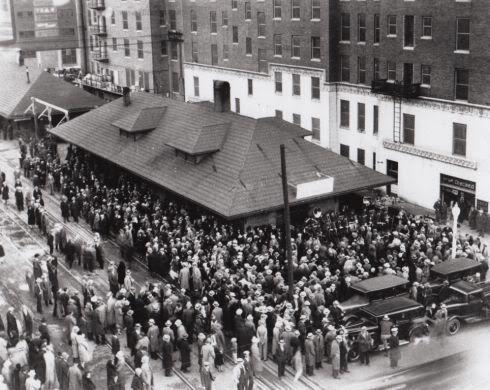
Other images in the article are Chamber of Commerce photos taken at Union Station on February 13, 1938, and a pair of Chamber images not shown in the article. Click any image for a larger view.
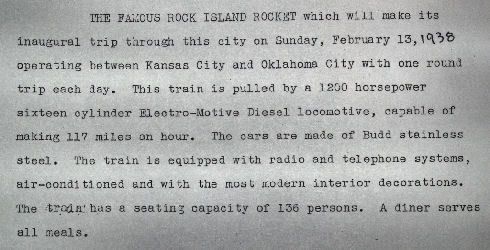
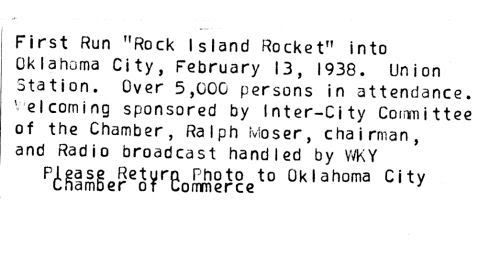
More Than 5,000 train fans showed up for the event!
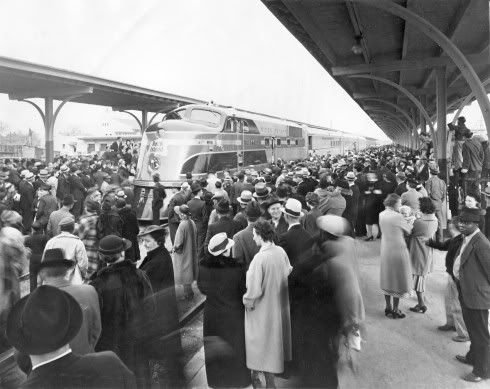
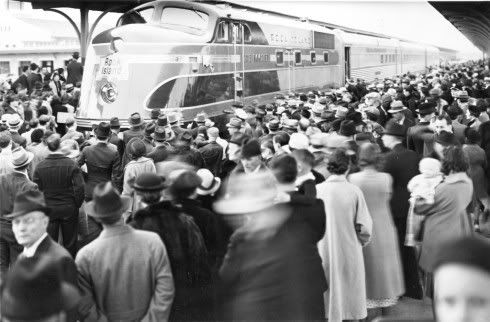
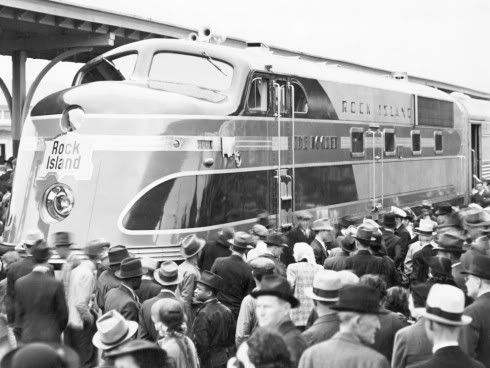

So, there you have it — the 1st installment in The Dean Schirf Collection! As long as he (Dean) remains willing, hopefully many more will follow!
Go To Trains 2 Go To Trains 3A
Go To Trolleys Part 1
Go To Top















4 comments:
All I can say is ...wow!
I love the old photos of the Rock Island roundhouse and the Walnut bridge. Neat stuff. Looking forward to more.
jb
I was born in Davenport, Ia. Somewhere in the late 40's while walking down to the Friendly House to watch the Saturday morning Penny Show (1 cent fee) I was walking through the alley's as I always did looking for good stuff that people would throw away I found a framed picture of the Rock Island Rock (601).It is still in the orginal frame. The Rocket would pass through the Quad City's. I still have the picture today and it hangs proudly in my Dad's pad bedroom in my daughter's house. I cannot tell you the joy I had in seeing the photo's of the Rocket as it showed up in Oklahoma City in 1938.
Great recollections, George! The photos and typed notes on their back make clear that the arrival of the Rocket on that day was a big day for OKC! If you ever want to scan your photo (I was a good alley trash can grubber in my youth, too, with some good finds, now and then), I'd be glad to post it as a Quad City kindred photo.
Great photos!
Post a Comment